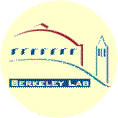December 17, 1998 |
|
 |
|
| Images:
Still images from the Supernova Cosmology Project website
|
The fate of the universe is a question of profound
philosophical interest, but practical benefits have also emerged from the Supernova
Cosmology Project. To wit:
Down-to-Earth Results From Far-Out Science: Technology The fate of the universe is a question of profound philosophical interest, but practical benefits have also emerged from the Supernova Cosmology Project -- partly because basic science continually requires new techniques and new tools. In order to get the best quality images of galaxies deep in space, Supernova Cosmology Project engineers fabricated a new kind of charge-coupled device (CCD), inspired by the particle detectors used in high-energy physics experiments. Instead of recording light patterns by chemical changes in photographic film, CCDs are doped semiconductor chips that convert light to minute electrical currents. To record blue light (shorter wave lengths) they must be illuminated from the back, which requires thinning the chips so that light-generated electrons can reach the wiring on the front. Consequently sensitivity to red light (longer wave lengths) can suffer -- indeed, if wavelengths are longer than the thickness of the chip, it does not see them at all. Led by Steve Holland, the Supernova Cosmology Project team devised a highly resistive chip much thicker than normal, one based on negatively doped silicon instead of the usual positively doped material; it mimics the electrical properties of a very thin chip. The new chip can be back-illuminated and is sensitive to blue light, but because it is thicker, it is also sensitive far into the infrared and is both sturdier and simpler to manufacture. The sturdy, inexpensive CCD promises benefits in medical image imaging, industrial process control, and commercial digital scanning, as well as for astronomy and other scientific applications. For further information, see http://pdg.lbl.gov/~deg/ccd.html. Down-to-Earth Results From Far-Out Science: Education Berkeley Lab astrophysicist Carl Pennypacker, a founder of the Supernova Cosmology Project with Saul Perlmutter, has more recently been in charge of Hands-On Universe, an educational program that enables high school and middle school students to use the resources of professional observatories. The Supernova Cosmology Project has supplied many of its hundreds of CCD images of the deep sky to students who use them, among other things, to search for unknown asteroids. Just last month one such search paid off spectacularly for astronomy students at Northfield Mount Hermon School in Northfield, Mass. In photos taken at Cerro Tololo in Chile, the team of three student asteroid searchers found an object 100 miles in diameter, now officially designated asteroid 1998 FS144, in the Kuiper Belt beyond Neptune. Their teacher, Hughes Pack, noted that only 72 such objects have been identified in the Kuiper Belt, and astronomer Tom Gehrels of the University of Arizona noted that before this discovery, only professional astronomers had found them. Says Pennypacker, "This is a fantastic piece of science, of education, of discovery . . . The Northfield students' discovery has shown that all students from a broad range of backgrounds can make solid, exciting and inspiring scientific contributions." For further information, see the Hands on Universe website at http://hou.lbl.gov and the news release announcing the Northfield Mount Hermon High School students' asteroid discovery at http://astronomy.geecs.org/asteroid_search/html/nmhpr.html An Embarrassment of Riches: Names and Numbers The method of finding supernovae "on demand" developed by the Supernova Cosmology Project has produced an embarrassment of riches in 1998 -- so many new supernovae that researchers can no longer depend on their memory of letter-number combinations to distinguish among individual events. Traditionally a new astronomical object is given a letter and number designation indicating approximately when it was found. Last year's very distant supernova, for example, discovered 5 March 1997, was dubbed SN 1997ap. But with dozens, even hundreds of supernova discoveries all beginning "SN 1998," a new strategy was called for. "So we decided to give them the names of famous people," Saul Perlmutter reports, "and since Rob Knop and I, the first to have a crack at naming them, are both classical violinists, we started naming them after composers." So far supernovae have been named after Bartok, Brahms, Elgar, Wagner, even John Cage. But the most eminent star in this stellar assembly -- whose unique claim to fame was announced at a DOE press conference in Washington on December 17, and will be discussed at the American Astronomical Society annual meetings early in 1999 -- is named Albinoni. "Everybody will get their chance to name supernovae after their heroes," Perlmutter says. "Maybe we'll give the football fans the next shot." Supernova Joe Montana? -- Paul Preuss
Back to the news release: "Science Magazine Names Supernova Research Breakthrough of the Year"
|